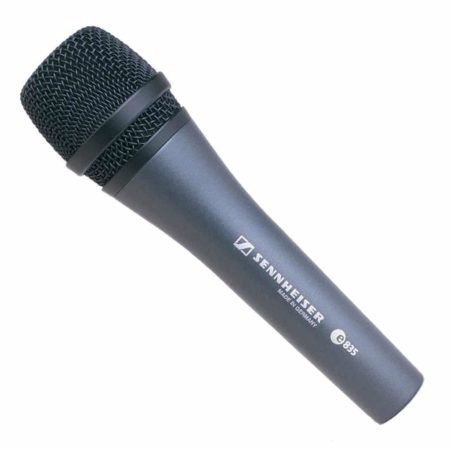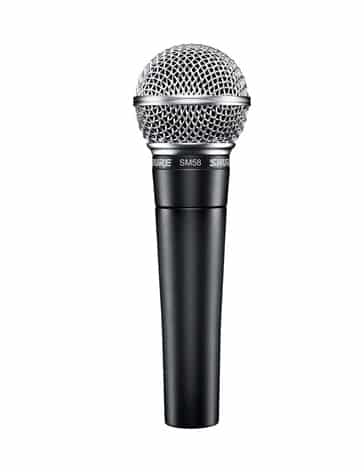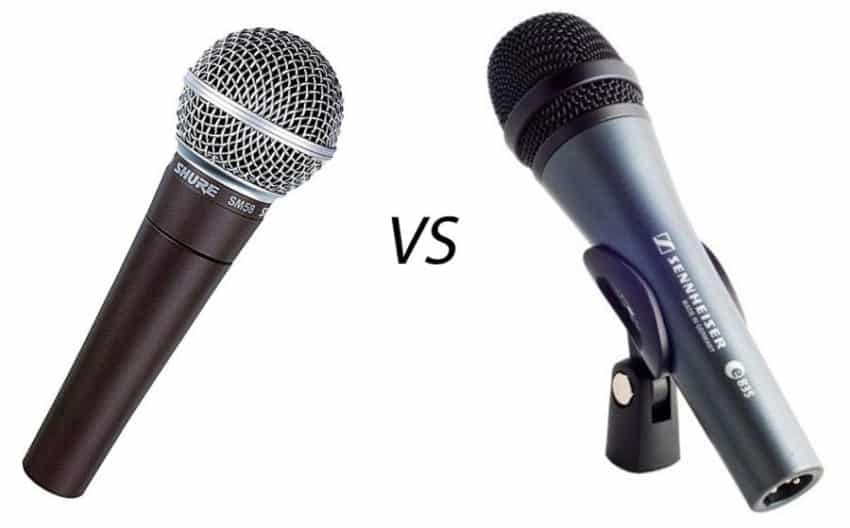Last updated on December 30th, 2023 at 02:54 pm
The Shure SM58 has been a staple in the music industry for decades now. It has been the go-to Microphone for live performances and odds are, you have seen videos of your favorite singer using one at multiple occasions.
Not only is this microphone known to be the standard in live performances, but It’s also used quite a lot in recording studios due to its high quality and versatility.
But it’s not the only option, nor necessarily the best one. At the same price range, you can find the Sennheiser e835 which is also extremely good, versatile and which has been used in the same situations as the SM58.
What’s great about both these microphones is the cost, since they are both really affordable.
Basic Differences between the Sennheiser e385 and the Shure SM58
The Sennheiser e835 has a more pronounced mid- and high-end which makes it better for live performances since vocals will sit better in the mix when even no EQ is applied. However, it’s not as good for screaming and loud vocals as the Shure SM58.
Sennheiser e835 Overview

The Sennheiser e835 is a handheld dynamic microphone, mostly used for vocals.
Like most cardioid dynamic microphones, this one handles noise really well and allows for great feedback rejection. Its construction is incredibly rugged which means that it should last you a long time, plus it comes with a 10 year warranty, which should give you confidence that it’s going to last.
This microphone is also designed with an advanced internal shock mount to stabilize and protect the capsule from handling noise that can be a problem at high volumes, and it’s got a uniform frequency pick-up pattern that maintains the signal quality when moving on and off axis during performance.
It has a mid-range and high-end boost, plus a bass roll-off which is great for making vocals sound more natural and warm plus it doesn’t need much EQ’ing them to sit well in a mix, which is why I like it for live performances.
What you get in the box
- Sennheiser e835 Microphone
- Microphone clip
- Pouch
Features
- Rugged metal body
- Excellent feedback rejection
- High sound pressure handling capability
- Shock-mounted capsule provides excellent suppression of handling noise
- Uniform on- and off-axis response
- Cardioid pick-up pattern provides isolation from other on-stage signals
- Hum compensating coil
- XLR-3
Specifications
| Polar Pattern | Cardioid |
| Microphone type | Dynamic |
| Sensitivity | 2.7mv/Pa |
| Frequency Response | 40 – 16.000 Hz |
| Item weight | 11.7 ounces / 330g |
| Output Impedance | 350 ohm |
| Dimensions | 4.8 x 18 cm |
Whether or not you prefer this microphone, comes down to your personal taste. Plus it also depends a lot on the kind of singing you do. For lower volume singing, the e835 definitely takes the lead over the SM58, while with really loud screaming voices, the SM58 would be your best bet!
I went to a live show once; the female singer was using a SM58. She was singing quite softly and the vocals were a bit muddy and almost unintelligible.
After about thirty minutes, she switched over to the Sennheiser e835 and the sound changed completely. Everything cleared up quite a bit! Like stated before though, it depends on your voice and you singing style.
Find out more about the Sennheiser e835 here:
- Sennheiser e835: Amazon, Sweetwater.
Shure SM58 Overview

The Shure SM58 is considered a staple in the recording industry and is, very possibly, the most well-known microphone there is!
It’s designed for professional vocal use in live performance, sound reinforcement, and studio recording.
This Microphone has a built-in pop-filter that is quite effective, although not perfect.
It has a steel mesh grille that ensures that even with rough handling, the SM58 will perform consistently and will also be able to out-live some of those times that it accidentally drops to the ground.
Just like the Sennheiser e835, the Shure SM58 has a built-in shock mount to cut down on handling noise, and is built like an absolute tank, so it’s really great for live performances and to take it on the road.
It also has a mid-boost and bass roll-off, but I prefer the e835 right out of the box since it definitely makes your vocals sit better in the mix. After EQ tough, they both sound fantastic!
What you get in the box
- Shure SM58 Microphone
- Microphone clip
- Pouch
Features
- Rugged and really durable metal body
- Great feedback rejection
- High sound pressure handling capability
- Shock-mounted capsule provides excellent suppression of handling noise
- Uniform on- and off-axis response (better than the e835 in my opinion)
- Cardioid pick-up pattern provides isolation from other on-stage signals
- XLR-3
Specifications
| Polar Pattern | Cardioid |
| Microphone type | Dynamic |
| Frequency Response | 50 to 15,000 Hz |
| Output Impedance | Rated impedance is 150 Ohms (300 Ohms actual) |
| Connector | Three-pin (XLR), male |
| Sensitivity | -57.5dB |
Similarities
- They are both great for recording and performing live.
- Both can be used for vocals and instruments.
- Both are around the same price.
- Build quality is fantastic on both.
Differences
- The Sennheiser e835 is quite similar sounding to the Shure SM58 but has more pronounced more high-end, which is important when recording cymbals, vocals and so on, and allows for a clearer and richer sound.
- The Sennheiser e835 has a better mid-range and has a high-end boost, which makes it sounds warmer.
- The Shure SM58 has the Sennheiser e835 beat when it comes to really loud and screaming vocals.
- The Sennheiser e835 doesn’t need that much EQ to sound great, while on the other hand, the Shure SM58 won’t sound as good UNTIL you EQ’d the track. Once you did that, they both sound very similar.
- The Shure SM58 wins the proximity battle. With the Sennheiser e835 you need to have it directly in front of the sound source, while the Shure SM58 gives you a bit more wiggle room.
- In the long term, the Shure SM58 may beat the Sennheiser e835 in the durability department, even though they are both of great quality.
I find myself reaching for EQ much less often when I use the Sennheiser rather than the SM58.
Whenever I use a SM58 on a live vocal I end up having to pull out some lows and low mids. I’ve always found it to be a bit more muddy.
Sennheiser on the other hand is much clearer right off the bat and needs much less EQ’ing to get it sounding good.
The issue with this is, that the mic has less room for EQ’ing before getting into poor territory. This means it can’t be pushed with EQ like the SM58 can. In this case the Sennheiser e835 would resemble a finished product, while the Shure SM58 would resemble more of a canvas.
For certain applications, like live performances, this is actually useful which means that the Sennheiser e835 will almost always win. But you can’t “customize” it s sound as much, if that makes sense.
Since these are dynamic microphones, they don’t require phantom power. But you will need a Mixer or an Audio Interface to be able to use them to record music. Don’t forget to get a mic stand and a windscreen also, should you need them!
Find out more about the Shure SM58 here:
- Shure SM58: Amazon, Sweetwater.
Mixer and Audio Interfaces Alternatives
Interfaces
Focusrite Scarlett 2i2 (comes with Pro Tools First).
Behringer U-Phoria UMC204HD
Check this article I wrote where I do an In-Depth comparison of both these Audio Interfaces.
Mixers
Mackie ProFX8v2 8-Channel Effects Mixer (this one only has Stereo Output, so it’s not great for multitrack recording but good for live settings).
Alesis MultiMix 8 USB FX (which can do 8 multitrack recordings at the same time, also can be used live).
If both of these microphones aren’t what you’re looking for, then make sure to read this article I wrote about the 16 best microphones under $300.
Conclusion
After all the research I’ve done, trying the microphones, reading reviews on forums, etc, i have come to the conclusion that the Sennheiser e835 wins this one, though not by that much. It’s just simpler to get a great sound. It should be extremely clear that no matter which one you choose, you will get a great piece of equipment.
As with many things, it all comes down to personal taste.
Check Prices for Both Microphones here: Sennheiser e835 and the Shure SM58.
I hope this was useful! have a great day!
F.A.Qs.
Does Sennheiser e835 need phantom power? The Sennheiser e835 is a dynamic microphone which means that it doesn’t require any Phantom Power to work since it’s capable of producing a powerful enough signal on it’s own, as is the case with all dynamic microphones.

Thank you for your review on SM58 vs Sennheiser e835…I use the sm58 beta, live performances mainly, which I love, but was wondering if you would still put the sennheiser ahead of the beta model.?
Thanks in advance for any comments.
I really appreciated your commentary explaining the difference between the XLR and USB microphones. One item that you did not mention is the use of headsets during voice recording using the XLR microphones. Please discuss the role of headsets in improving the audio quality. Thank you!